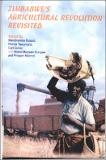| dc.contributor.author | Jayne, T.S. | |
| dc.contributor.author | Chisvo, M. | |
| dc.contributor.author | Rukuni, M. | |
| dc.contributor.author | Masanganise, P. | |
| dc.coverage.spatial | Zimbabwe. | en |
| dc.date.accessioned | 2016-03-14T11:38:40Z | |
| dc.date.available | 2016-03-14T11:38:40Z | |
| dc.date.issued | 2006 | |
| dc.identifier.citation | Jayne, T..S. et al., ( 2006) Zimbabwe’s food insecurity paradox: hunger amid potential. In: Rukuni, M., Tawonezvi, P. and Eicher, C. (eds.) Zimbabwe's agricultural revolution revisited. UZ, Mt. Pleasant, Harare: UZ Publications, pp. 525-541. | en |
| dc.identifier.isbn | 0-86924-141-9 | |
| dc.identifier.uri | https://opendocs.ids.ac.uk/opendocs/handle/20.500.12413/10011 | |
| dc.description | A research paper on the paradox of poverty in a situation of great potential agricultural yields in Zimbabwe's quest for food security. | en |
| dc.description.abstract | Food security is one of the primary goals for human and sustainable development the world over. At the global level, one of the millennium development goals is halving the number of undernourished people in the world by 2015. In Zimbabwe, food security has been at the centre of development goals and strategies since independence in 1980. Zimbabwe has also ratified all the conventions regarding sustainable development, including the United Nations Millennium Development Goals. In the 1980s, Zimbabwe received international acclaim for its agricultural policies and grain surpluses212 but many households in the rural areas faced chronic food insecurity. Although Zimbabwe has the potential to achieve food security, it has experienced food shortages since the 1990s at both the national and household levels.
Food self sufficiency in Zimbabwe could be achieved primarily through production and then distribution to the population through appropriate marketing policies and channels. In 1985, grain self-sufficiency was 212 per cent and Zimbabwe was regarded as the grain basket of the Southern African Development Community." However, production of the main staple food crops has been declining over the years. Whilst low production can be attributed to poor and erratic rainfall, low soil fertility and other institutional and policy factors have been responsible for lagging production from the 1999/2000 season onwards. | en |
| dc.language.iso | en | en |
| dc.publisher | University of Zimbabwe (UZ) Publications | en |
| dc.rights.uri | http://creativecommons.org/licenses/by-nc-nd/3.0/ | en |
| dc.subject | Nutrition | en |
| dc.subject | Poverty | en |
| dc.subject | Social Protection | en |
| dc.title | Zimbabwe’s food insecurity paradox: hunger amid potential | en |
| dc.type | Book chapter | en |
| dc.rights.holder | University of Zimbabwe (UZ) | en |


